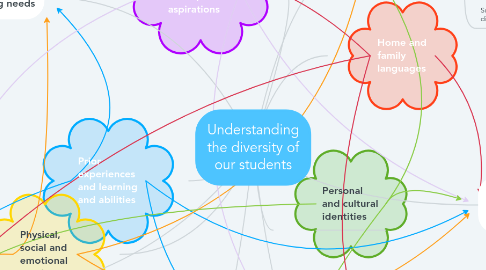
1. Connect with Families
1.1. At the beginning of the year send a survey to collect information about your student's routines at home and lifestyle.
1.2. Set opportunities for families to come in and share their cultural values and beliefs.
1.3. Share the school values with families
1.4. Host parent nights at the beginning of the year to connect with families in your class.
1.5. Have a weekly newsletter to share the learning and upcoming learning and see if parents might be able to be involved.
2. Meet diverse learning needs
2.1. Spend time observing and assessing your learner's needs the first weeks of school
2.2. Bring your support services staff into the conversation on how best to support students in the classroom
2.3. Talk to previous teachers about students learning needs and strategies that might have worked for them
2.4. Explicitly teach strategies to learn how to Listen, Speak to each other, Collaborate, Self regulate and values like responsibility, kindness, respect, empathy etc.
2.5. Plan with your diverse cohort in mind. Using a range of tools and strategies depending on the learning at hand.
2.5.1. Adaptive technologies
2.5.2. Flexible Grouping
2.5.3. Visual prompts
2.5.4. Auditory prompts
2.5.5. Vocabulary lists
2.5.6. Graphic organizers
2.5.7. Prompt questions
2.5.8. Timers
2.5.9. Lists of broken down instructions
2.5.10. Project Based Learning
2.5.11. Differentiated Instruction
3. Professional Development
3.1. Seek professional development opportunities to promote and support diversity in your classroom
4. Prior experiences and learning and abilities
5. Physical, social and emotional needs
6. Interests, perspectives, needs, aspirations
7. Get to know your students
7.1. Socio-economic situation
7.2. Where they come from
7.3. Learning needs
7.4. Social and Behaviour needs
7.5. Strategies:
7.5.1. Schedule time to meet with each student to discuss their interests and family life.
7.5.2. Hopes and Dreams: Teach students about their differences and how they all have different learning needs.
7.5.3. Touch base with students through a weekly letter system
7.5.4. Use morning meetings to cultivate class spirit and a sense of community.
8. Think about your teaching materials
8.1. Different Perspectives: Make sure you have a range of voices influencing what your students learn. Think which voices are missing and add them to your repertoire.
8.2. Think of different text complexities
8.3. Look for materials that matches student interest.
9. Inclusion and Inequality
9.1. Establish time to teach and talk about inequality in student's life.
9.2. Teach students how to address inequality and how to promote inclusion.
9.3. Build inclusive routines within your classroom culture.
9.3.1. How to accept different peers as partners,
9.3.2. How to value different peer's perspectives and disagree with respect.
